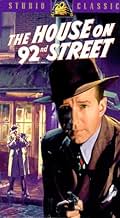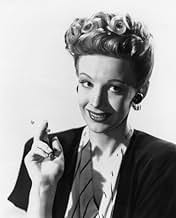VALUTAZIONE IMDb
6,6/10
3372
LA TUA VALUTAZIONE
Bill Dietrich diventa un doppiogiochista per l'FBI in un giro di spie naziste.Bill Dietrich diventa un doppiogiochista per l'FBI in un giro di spie naziste.Bill Dietrich diventa un doppiogiochista per l'FBI in un giro di spie naziste.
- Vincitore di 1 Oscar
- 2 vittorie totali
William Post Jr.
- Walker
- (as William Post)
William Adams
- Customs Officer
- (non citato nei titoli originali)
Frieda Altman
- Saboteur
- (non citato nei titoli originali)
William Beach
- Saboteur
- (non citato nei titoli originali)
Carl Benson
- German Spy Trainee
- (non citato nei titoli originali)
Hamilton Benz
- Saboteur
- (non citato nei titoli originali)
Trama
Lo sapevi?
- QuizThe movie deals with the theft by German spies of the fictional "Process 97", a secret formula which, the narrator tells us, "was crucial to the development of the atomic bomb." The movie was released on September 10, 1945, only a month after the atomic bombs had been dropped on Japan, and barely a week after Japan's formal surrender. While making the film, the actors and Director Henry Hathaway did not know that the atomic bomb existed, nor that it would be incorporated as a story element in the movie. (None of the actors in the film mentioned the atomic bomb.) However, co-Director and Producer Louis De Rochemont (who produced the "March of Time" newsreel films) and Narrator Reed Hadley were involved in producing government films on the development of the atomic bomb. (Hadley was present at the final test of the bomb in Los Alamos, New Mexico, in July, 1945.) After the bomb was dropped on Hiroshima, Hadley and Screenwriter John Monks, Jr. hastily wrote some additional voice-over narration linking "Process 97" to the atomic bomb, and Rochemont inserted it into the picture in time for the film's quick release.
- BlooperThe description of a one-way mirror as an "X-ray" mirror at the beginning is nonsense. A one-way mirror is in fact merely a partially-silvered mirror. It becomes "one-way" by virtue of different lighting on either side - one side dimly lit, the other brightly lit. From the side that's brightly lit, it appears to be a normal mirror because the reflection washes out any light coming through from the dim side. But from within the dim side, everything on the bright side is readily visible because the light coming through predominates over the reflection seen from the dim side.
- Citazioni
Agent George A. Briggs: We know all about you, Roper. We've traced you to the day you were born. We even know the approximate day you will die.
- Curiosità sui creditiOpening credits are shown as someone flipping through the pages of a file.
- ConnessioniReferenced in 23 passi dal delitto (1956)
- Colonne sonoreTra-La-La-La
(uncredited)
Music by Harry Warren
Played as background music at the talent agent's office
Recensione in evidenza
This semi documentary film, shows the FBI at work in those early days of the European conflict. Henry Hathaway, the director, focus on the work behind the scenes of a group of German spies, operating in New York and how the FBI is able to infiltrate the group.
The film, as seen today, still holds the viewer's attention, although the technology is obsolete by today standards. We are given a suspenseful story about the group that established the base of operations in the house on 92nd Street and Madison Avenue in the Manhattan of the 40s. The crisp black and white cinematography by Norbert Brodine still looks pristine and sharp.
The cast headed by Lloyd Nolan as Briggs, do a good job under Mr. Hathaway's direction. Best of all is Signe Hasso as Elsa Gebhart, the designing woman with a lot of secrets. Leo G. Carroll is also seen as one of the spies. Gene Lockhart also has a minor role.
It was fun to watch uncredited New York based actors in the background such as E.G. Marshall, Vincent Gardenia, Paul Ford, among others making small contributions to the film.
The film, as seen today, still holds the viewer's attention, although the technology is obsolete by today standards. We are given a suspenseful story about the group that established the base of operations in the house on 92nd Street and Madison Avenue in the Manhattan of the 40s. The crisp black and white cinematography by Norbert Brodine still looks pristine and sharp.
The cast headed by Lloyd Nolan as Briggs, do a good job under Mr. Hathaway's direction. Best of all is Signe Hasso as Elsa Gebhart, the designing woman with a lot of secrets. Leo G. Carroll is also seen as one of the spies. Gene Lockhart also has a minor role.
It was fun to watch uncredited New York based actors in the background such as E.G. Marshall, Vincent Gardenia, Paul Ford, among others making small contributions to the film.
I più visti
Accedi per valutare e creare un elenco di titoli salvati per ottenere consigli personalizzati
- How long is The House on 92nd Street?Powered by Alexa
Dettagli
- Data di uscita
- Paese di origine
- Lingue
- Celebre anche come
- The House on 92nd Street
- Luoghi delle riprese
- Amburgo, Germania(second unit)
- Azienda produttrice
- Vedi altri crediti dell’azienda su IMDbPro
Botteghino
- Lordo Stati Uniti e Canada
- 2.500.000 USD
- Tempo di esecuzione1 ora 28 minuti
- Colore
- Proporzioni
- 1.37 : 1
Contribuisci a questa pagina
Suggerisci una modifica o aggiungi i contenuti mancanti

Divario superiore
By what name was La casa della 92ª strada (1945) officially released in India in English?
Rispondi





























